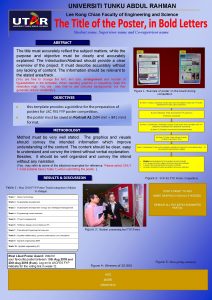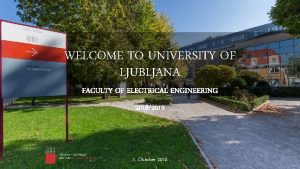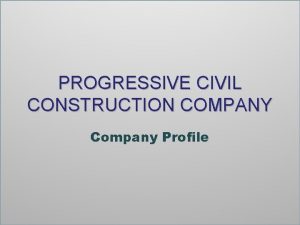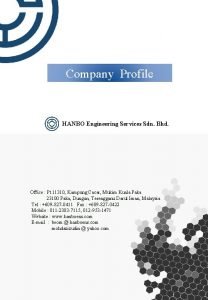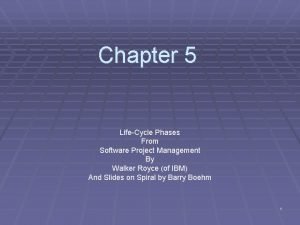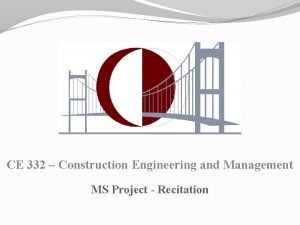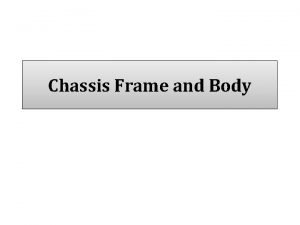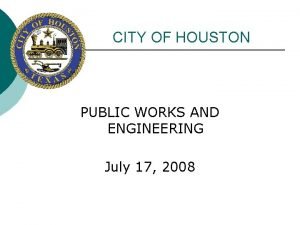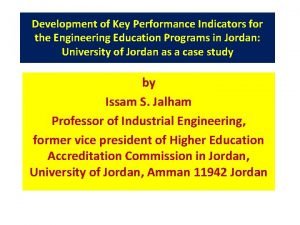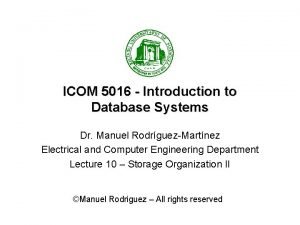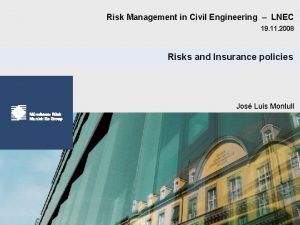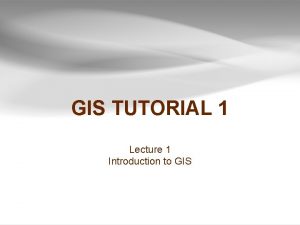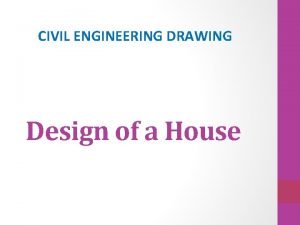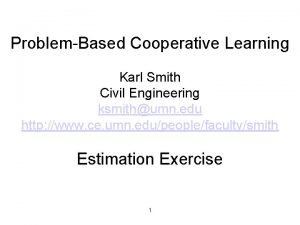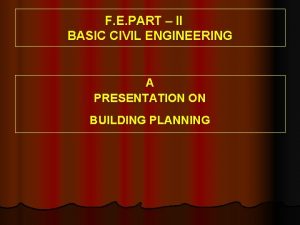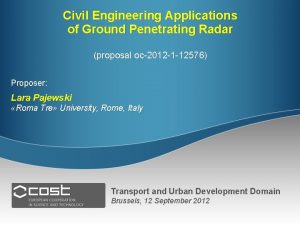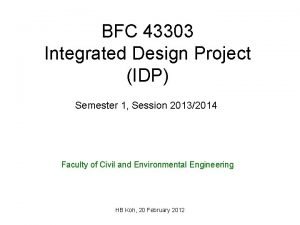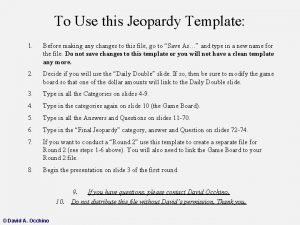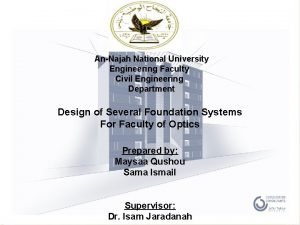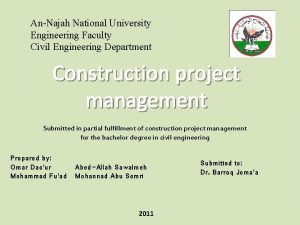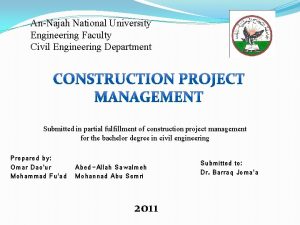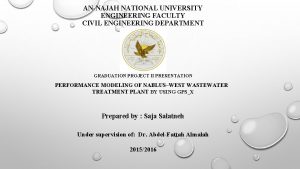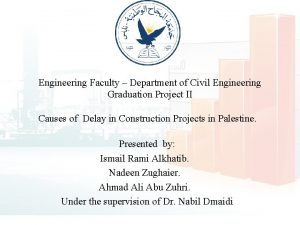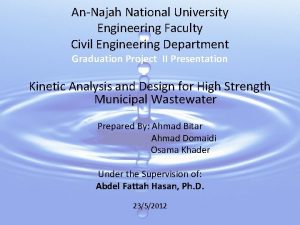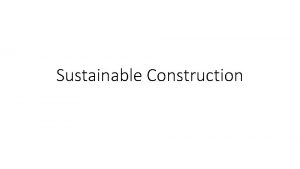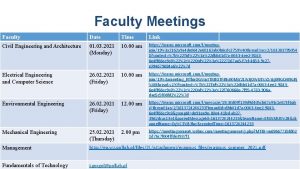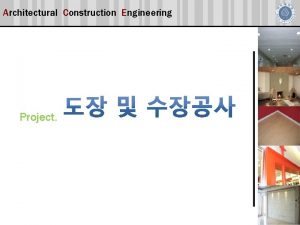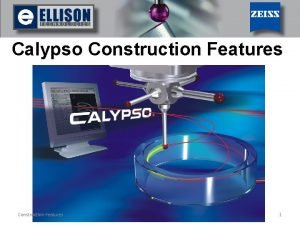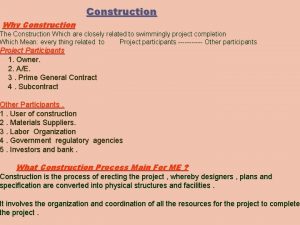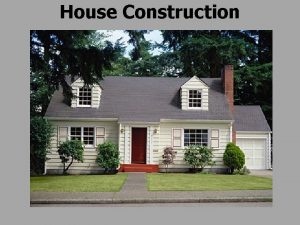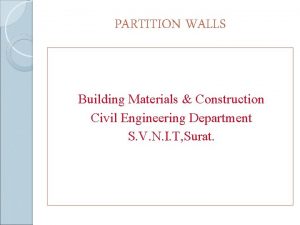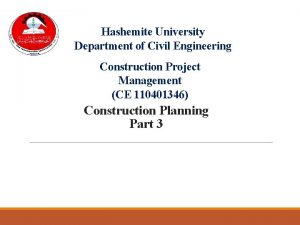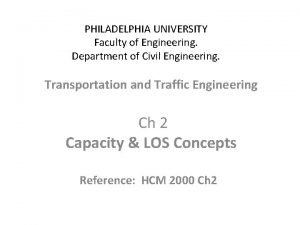YT Civil Engineering Faculty Civil Engineering Department Construction

























































- Slides: 57

YTÜ Civil Engineering Faculty Civil Engineering Department/ Construction Management Division. Developing investment projects & Feasibility studies

Investment Project Concept Investment is putting money into an asset with the expectation of capital appreciation, dividends, and/or interest earnings. Investment Project, is long- term allocation of funds (with or without recourse to the project's sponsor) to carry an investment idea through to its stable-income generation stage. Investment should create capacity which has long term life. The inputs of the investment should be physical resources (such as raw material, work force, capital materials) The investment should provide products and services to internal and external parties. Soyak/ Hizmete Özel Belge

Investment projects n Identification of the purposes is important since it determines the investment direction and can be used as criteria in selection of the investment, n Identification of the probable problems, and effects of these problems by performing situation analysis. n There are mainly three stages in the investment projects plan; § § § Determination of alternative solutions, Estimation of alternatives, Evaluation Stage. Soyak/ Hizmete Özel Belge

Types of Investment n Investments related to production: Corporation Investments n Operation Investments n n Repair n Amendment n Renovation investments n Replacement n Expansion n Preservation Soyak/ Hizmete Özel Belge

Outputs of investment projects n n n The existing capacity is expanded or a new capacity is developed. The investment project demands and uses physical resources from the economy such as work force, capital and natural resources. It leads to application of production technology. By investment projects, the corporations can; n Decrease the risks, n Increase the economic benefits, n Improve the management process, n Develop new production opportunities in the country, n Prioritize the production of resources which have lowest risk level. Soyak/ Hizmete Özel Belge

Investment projects in preparation and evaluation of investment n The dynamic effects of investments, which are basis of economic growth, on the developing economy can be summarized by considering n n accelerating and stimulating effects. The simulating effects of the investment implies that the money spent for investments leads to much more increase in the gross domestic product of the country. Soyak/ Hizmete Özel Belge

Preparation of feasibility studies Purpose of feasibility studies; n providing optimum resource utilization, n In this perspective, the feasibility study can be considered as a guide to make appropriate investment. n ascertain the decision of establishment of an investment, n determination of the size and location of the company, Soyak/ Hizmete Özel Belge

Preparation of feasibility study n if the investment requires internal or external funding, the feasibility study can be used as a preliminary project to convince the financial corporations, n to present the project to the government agencies in order to satisfy governmental financial supports, n to identify the risks emerged throughout the application of the project and taking necessary actions to eliminate the effects of these risks. Soyak/ Hizmete Özel Belge

Parts of feasibility study n Introduction; general information about the investor and investment n Economic Study, n Technical Study, n Financial Study, n Conclusion. Soyak/ Hizmete Özel Belge

Stages in investment Soyak/ Hizmete Özel Belge

Preliminary Research in the Preparation of Investment Projects n Identification of investment requirement, n Materialization of the investment requirement, n Identification of investment alternatives, n Collection of the relevant information (related to the investment alternatives), n Performing preliminary control related to investment alternatives. Soyak/ Hizmete Özel Belge

Economic Study n n n Market research and demand forecasting, Capacity selection, n Maximum Capacity n Normal Capacity n Actual Capacity n Optimum Capacity: The capacity where the average unit total cost is minimum Capacity usage ratio= Actual Capacity/ Normal Capacity Determination of the location of the corporation. Soyak/ Hizmete Özel Belge

The importance of the selection of the capacity; n Scale economy (Decrease in the average unit cost with increasing quantity). The factors which affect the capacity; n since the determination of the capacity depends on many factors, this is a very difficult process. Soyak/ Hizmete Özel Belge

Costs n In order to select the appropriate capacity, the determination of cost functions obtained for different capacity usages are required. n The cost function can be formulated as C=f(Q); the cost can change with the change in the quantities and prices of production factors. n The effects of the costs on selection of the capacity can be varied within the duration. n In other words the effect of the cost in the short term can be different than the effect of the cost in the long term. Soyak/ Hizmete Özel Belge

Short term costs n In this period, no change emerges in the investment structure and organization of the company. In other words, we do not expand or renovate the production facility. n Total Fixed costs; do not change within a given time period, although volume may change. n Total Variable costs; can change with respect to the production quantity and are essential for production. Soyak/ Hizmete Özel Belge

Short Term costs Average Unit costs; n Average Fixed costs= Total Fixed cost/ Quantity of production n Average Variable costs= Total Variable cost/ Quantity of production n Average Total costs= Total Cost/ Quantity of production Soyak/ Hizmete Özel Belge

Long term costs n These costs occur at the end of the economic life of the investment, in other words these costs are related to the replacement of the investment. n Since the technology is updated and the capacity is increased, the average unit cost decreases. Soyak/ Hizmete Özel Belge

Land Selection n Closeness to the target market n Closeness to the resources n Workforce Methods; v. Scoring method, v. Cost comparison method, v. Benefit comparison method, v. Profit comparison method. Soyak/ Hizmete Özel Belge

Determination of production program Selection of machines and equipment n Determination of required work force n Soyak/ Hizmete Özel Belge

Technical survey Determination of technical design of the product, Selection of the production method and technology; The reason of selection, acquiring method (licence, purchasing, joint venture), the alternative technologies and their costs Determination of required work force, required qualified and unqualified workers, inspector and managers, training requirement, the required work force and their costs at post project and during project. Work Flow charts and determination of required facilities in construction site and allocation of these facilities; identification of location of production, technical offices and other facilities that support the production Preparation of product plans; Who will conduct project activities and how they will do that and the cost of the production Determination of material requirements, Calculation of construction cost. Soyak/ Hizmete Özel Belge

Financial survey n Calculation of the total cost of the project, n Determination of required capital investment, total investment finance and capital structure n Calculation of the incomes throughout the construction period n Estimation of the total incomes and costs at the end of the project and profitability of the project n Evaluation of the project in the financial perspective. Soyak/ Hizmete Özel Belge

Conclusion and demand n The preparation of the reports related to the project according to the purposes of the stakeholders. Soyak/ Hizmete Özel Belge

n Risk Premium n Is the rate set by an organization to designate the lowest level of return that makes an investment acceptable. Cost of capital (sermaye maliyeti) Risk premium (risk primi) n If the risk of the project is high, the risk premium calculated for this project will also be high. In other words, the risk premium increases with increasing risk. Cost of Capital n MARR Minimum attractive rate of return (yatırımın geri dönüşü) Soyak/ Hizmete Özel Belge

Cost of capital n Equity (özsermaye) financing: the corporation uses its own funds from cash on hand, stock sales or retained earnings. n Debt (borç) financing: the corporation borrows from outside sources and repays the principal and interest based on a specified plan. n Bonds n Loans n Mortgages etc. Soyak/ Hizmete Özel Belge

Risk Premium n Business risks n Financial risks n Market risks n Interest risks etc. Soyak/ Hizmete Özel Belge

Net Present Value; NPV n A future amount of money converted to its equivalent value now has a present worth (PW) that is always less than that of the actual cash flow. n Net present value is a standard method to evaluate the long term projects. Soyak/ Hizmete Özel Belge

Net Present Value; NPV n n Net present value is obtained by adding present values of all transactions. If NPV is positive, this shows that the investment is profitable. On the other hand, if it is negative, this means that the costs of the investment are higher than the revenues of this investment. When it is calculated as zero, then this investment is at the breakeven point. Soyak/ Hizmete Özel Belge

Example 1 n Perform a present worth analysis of equalservice machines with the costs shown below, if the MARR is 10% per year. Revenues for all two alternatives are expected to be the same. Electricpowered Initial cost Gas-powered -2500 -3500 Annual operating costs -900 -700 Salvage value 200 350 5 5 Life, years Soyak/ Hizmete Özel Belge

Example 1 Electricpowered Gas-powered -2500 -3500 Annual operating costs -900 -700 Salvage value 200 350 5 5 Initial cost Life, years n PWe= - 2500 - 900(P / A, 10%, 5) + 200(P /F, 1 O%, 5) = $- 5788 n PWg = - 3500 - 700(P/A, 10%, 5) + 350(P/ F, 10%, 5) = $-5936 n The electric-powered machine should be preferred. Soyak/ Hizmete Özel Belge

Rate of Return; ROR n Rate of return (ROR) is n the rate paid on the unpaid balance of borrowed money, n or the rate earned on the unrecovered balance of an investment, so that the final payment or receipt brings the balance to exactly zero with interest considered. n The rate of return is expressed as a percent period, for example, i = 10% per year. Soyak/ Hizmete Özel Belge

Rate of Return; ROR n ROR is an important indicator in selecting project. n To determine the rate of return of a cash flow series, PW relations can be used to set up the ROR equation. n The present worth of costs or disbursements (harcama) PWd is equated to the present worth of incomes or receipts PWr. Soyak/ Hizmete Özel Belge

Example 2 n The HVAC engineer for a company constructing one of the world's tallest buildings (Shanghai Financial Center in the Peoples' Republic of China) has requested that $500, 000 be spent now during construction on software and hardware to improve the efficiency of the environmental control systems. n This is expected to save $10, 000 per year for 10 years in energy costs and $700, 000 at the end of 10 years in equipment refurbishment costs. Find the rate of return. Soyak/ Hizmete Özel Belge

Example 2 Soyak/ Hizmete Özel Belge

Example 2 n Soyak/ Hizmete Özel Belge

n n n 5% --- $6, 946 6% --- $-35, 519 ? ---- $0 For 1% increase (5 to 6)%, difference is (6, 946 -(-35, 519)=$42, 465). For (x%), how much is required from $6, 046 to have $0 is required? 1 42, 465 X (6, 946 -0) ---------x=0. 16% ------ 5. 16% Soyak/ Hizmete Özel Belge

Return of Investment; ROI n ROI is a performance measure used n to evaluate the efficiency of an investment or, n to compare the efficiency of a number of different investments. n To calculate ROI, the benefit (return) of an investment is divided by the cost of the investment; the result is expressed as a percentage or a ratio. n ROI = (gains from investment/ investment amount) x 100 Soyak/ Hizmete Özel Belge

Return of Investment; ROI n Return on investment (ROI) is a very popular metric because of its versatility and simplicity. n If an investment does not have a positive ROI, it should be reconsidered. n If there are other opportunities with higher ROI values, then the investment with higher ROI should be reconsidered. Soyak/ Hizmete Özel Belge

Benefit / Cost Ratio n The benefits obtained at the end of the project is divided to the costs spent for the project to determine the benefit cost ratio. Ø B/C ratio is larger than one; the benefit of the project is higher than the cost of the project. For example, if the “B/C ratio is equal to 2. 5 ", the project provides benefit whose worth is 2. 5 TL, and it cost is 1 TL. Ø B/C ratio is smaller than one; the benefit of the project is smaller than the cost of the project. Ø B/C ratio is equal to one; Project is at the breakeven point. Soyak/ Hizmete Özel Belge

Payback Period (Geri Ödeme Süresi) n Payback analysis (also called pay-out analysis) is another form of sensitivity analysis that uses a PW equivalence relation. n The point where the project starts to earn profit. (Breakeven point) n The payback period is the time, that estimated revenues and other economic benefits start to recover the initial investment P. Therefore, the alternative which has shorter payback period is the better alternative. Soyak/ Hizmete Özel Belge

Example 4 n A company has two machine alternatives whose economic lives are given as 6 years for both. The price and annual income of these machines are given in the following table. According to the no return payback period, determine the alternative the company should invest. Alternatives Cost (TL) Annual income (TL/yr) Machine A 200 000 45 000 Machine B 300 000 60 000 Soyak/ Hizmete Özel Belge

Example 4 n n n Payback Period 1= 200 000/45 000 = 4. 4 years Payback Period 2= 300 000/60 000 = 5 years According to the payback periods, first alternative should be preferred. Soyak/ Hizmete Özel Belge

Example 5 n Compute the payback period of the following cash flow both for the no return and MARR = 10 % payback periods. End of 0 1 2 3 4 5 6 -100 25 30 25 -10 45 45 year Cash Flow Soyak/ Hizmete Özel Belge

Example 5 Years 0 1 2 3 4 5 6 Cash Flow -100 25 30 25 -10 45 45 PW -100 22. 73 24. 79 18. 78 -6. 83 27. 94 25. 40 -100 -77. 27 -52. 48 -33. 70 -40. 53 -12. 59 12. 82 Cumulative present worth n P=F(1+i)-n n Single payment, future worth is given, find present worth Soyak/ Hizmete Özel Belge

Opportunity Cost n An opportunity cost is the benefit lost by choosing one opportunity instead of another better alternative due to the limited resources of the company. n The opportunities which are eliminated due to the limited resources are examples of this type of costs. Soyak/ Hizmete Özel Belge

Investment in Housing Sector Soyak/ Hizmete Özel Belge

Idea – Preliminary Feasibility study/ Targeted Market Risk Management Finding the construction field Quality Management Market research– Social, Economical and demographical studies – When is the right time? Communication Management Financial Analysis Concept Human Resources Management Schedule / Cash Flow Schedule Management Contract Project Development Cost Management Communication Construction Marketing Permissions Delivery Service after construction Management Soyak/ Hizmete Özel Belge

Preliminary stages in project development; n n Evaluation of market and company, Evaluation of legal and political situation, (Strengths, Weaknesses, Opportunities, and Threats Analysis) n Observe the development of the city. Soyak/ Hizmete Özel Belge

Basic indicators in residential building market n Residential building sector indicators; n n Number of licences (ruhsat adetleri), Number of settlement permission (iskan adetleri, Volume of mortgage credits (konut kredisi hacmi), Number of mortgages (kullanılan konut kredisi sayısı). Soyak/ Hizmete Özel Belge

Residential Buildings Housing construction (thousands) (*) 548 600 433 524 400 393 473 454 381 547 600 582 501 464 339 315 2008 July 388 thousands 330 280 162 Settlement Permission 2008 501 thousands 518 203 Use Permission 0 1991 1992 1993 1994 1995 1996 1997 1998 1999 2000 2001 2002 2003 2004 2005 2006 2007 2008 (*) Turkish Statistical Institute. Annual sale volume of houses (thousands) (**) 1, 500 1, 250 1, 216 1, 014 1, 000 937 924 1, 363 1, 378 1, 018 Sale of houses 750 500 250 197 24 13 2000 2001 8 1, 384 14 57 2003 2004 230 232 House mortgages 0 2002 2005 2006 2007 (**) General Directorate of Land Registry and Cadastre. Soyak/ Hizmete Özel Belge

Indicators in office buildings n n Emptiness ratio (boşluk oranı) Used capacity (emilim, sunulan-kullanılan m 2 ünite) Total stock m² (toplam stok) Average rent (ortalama kira) It is important to consider global and local economic conditions along with these indicators. Soyak/ Hizmete Özel Belge

Indicators in retail center market n n n Total rentable area, Household consumption expenditure, Retail center floorspace by 1000 inhabitants, New retail supply, Types of existing retail centers. Soyak/ Hizmete Özel Belge

The models used in business development in housing sector n Partnership and joint ventures n Share the revenues (Hasılat paylaşımı) n Build-Operate-Transfer (Yap-İşlet-Devret) n Build-Operate (Yap-İşlet) n Leasing (Kiralama) n Public-Privtae Partnerships (Kamu özel sektör işbirliği) n Share in building structure (Kat karşılığı) Soyak/ Hizmete Özel Belge

Construction Conditions n Construction Field Area(Brüt İnşaat Alanı): The total area of the floors placed between basement, mezzanine, and roof. Common areas other than skylight (ışıklık), shaft (hava bacaları), water table (saçaklar), fire ladders placed outside the building are considered. n Floor area coefficient(Taban Alanı Kat Sayısı, TAKS): The ratio of the floor area of the construction to the area of reconstruction parcel. This shows the largest floor area of the construction on the construction field. It cannot be larger than 1. 00. Soyak/ Hizmete Özel Belge

Construction Conditions n Total floor area coefficient(Kat Alanı Kat Sayısı, KAKS): The ratio of the total construction area to the construction field. The construction area cannot be exceed to the total floor area coefficient. n Precedent (Emsal, İnşaat yoğunluğu): The ratio of the construction area to the reconstruction parcel. Usually, it is considered as KAKS. The height of the building is determined by considering this coefficient and hmax. Soyak/ Hizmete Özel Belge

Construction Conditions n Hmax (Maksimum Yapı Yüksekliği): The maximum height of the construction n Floor height= h; Usually it is taken 3 meters. Soyak/ Hizmete Özel Belge

Example 1 n The field area is 1500 m² n TAKS = 0. 2 , KAKS = 2 n This means that; n 1500 x 0. 2 = 300 m² The floor area of the construction n 1500 x 2 = 3000 m² The total construction area n 3000 / 300 = 10 floors Ø Number of floors A 10 storey building whose floor area is 300 m² can be constructed on this field. if there is no contrary condition on the plan notes; Ø A 15 storey building whose floor area is 200 m² can be constructed. Ø A 10 storey building whose floor area is 200 m² and a 10 storey building whose floor area is 100 m² can be constructed. Soyak/ Hizmete Özel Belge

Example 2 Field area is 2000 m 2 n KAKS = Precedent = 2 , This means that; n n n Hmax = 30 m , h = 3 m 2000 x 2 = 4000 m² The total construction area Hmax / h = 30 / 3 = 10 Floors number of floors Ø On this field, buildings whose total construction is 4000 m², the maximum number of floor of these buildings is 10. If there is no contrary condition on the plan notes and TAKS=0. 25; Ø Floor area= 0. 25 x 2000 = 500 m 2 Ø A 10 storey building whose floor area is 300 m² and a 5 storey building whose floor area is 200 m² can be constructed. Ø A 20 storey building whose floor area is 200 m² cannot be constructed. Soyak/ Hizmete Özel Belge
 Faculty of civil engineering ctu prague
Faculty of civil engineering ctu prague Civil engineering faculty
Civil engineering faculty Nit calicut chemistry
Nit calicut chemistry Lee kong chian faculty of engineering and science
Lee kong chian faculty of engineering and science Benha faculty of engineering
Benha faculty of engineering Faculty of engineering university of porto
Faculty of engineering university of porto Usf electrical engineering faculty
Usf electrical engineering faculty St anns college chirala
St anns college chirala Etfbl
Etfbl Hijjawi faculty for engineering technology
Hijjawi faculty for engineering technology Roumieh university
Roumieh university Ece clemson
Ece clemson Lee kong chian faculty of engineering and science
Lee kong chian faculty of engineering and science Faculty of mechanical engineering thammasat university
Faculty of mechanical engineering thammasat university Faculty of engineering orientation
Faculty of engineering orientation Studis fe
Studis fe Construction business profile
Construction business profile Civil rights webquest
Civil rights webquest Geometric construction engineering drawing
Geometric construction engineering drawing Hanbo engineering & construction
Hanbo engineering & construction Construction phase in software engineering
Construction phase in software engineering Iran construction engineering organization
Iran construction engineering organization Construction engineering and management
Construction engineering and management Function of chassis frame
Function of chassis frame Electrical engineering department
Electrical engineering department Engineering department in a hotel
Engineering department in a hotel City of houston idm
City of houston idm Engineering key performance indicators
Engineering key performance indicators Department of information engineering university of padova
Department of information engineering university of padova Department of information engineering university of padova
Department of information engineering university of padova Tum
Tum M tech structural engineering
M tech structural engineering University of bridgeport computer science
University of bridgeport computer science Bridgeport engineering department
Bridgeport engineering department Computer engineering department
Computer engineering department Ucla electrical engineering department
Ucla electrical engineering department University of sargodha engineering department
University of sargodha engineering department Unsw 8621
Unsw 8621 Hse in civil engineering
Hse in civil engineering Civil engineering risk management
Civil engineering risk management Tam grout
Tam grout What is formwork in civil engineering
What is formwork in civil engineering Introduction to civil engineering
Introduction to civil engineering Role of civil engineering
Role of civil engineering Gis applications in civil engineering
Gis applications in civil engineering House civil engineering drawing
House civil engineering drawing Bisection method application in civil engineering
Bisection method application in civil engineering Umn civil engineering
Umn civil engineering Kambiz farahmand
Kambiz farahmand Walls engineering works
Walls engineering works Roominess in civil engineering
Roominess in civil engineering Civil engineering applications of ground penetrating radar
Civil engineering applications of ground penetrating radar Idp project for civil engineering
Idp project for civil engineering Engineering flowsheet ub
Engineering flowsheet ub Cuban american civil engineering association
Cuban american civil engineering association Branch of civil engineering
Branch of civil engineering What is ndt test of concrete
What is ndt test of concrete Reconciliation meaning in civil engineering
Reconciliation meaning in civil engineering












